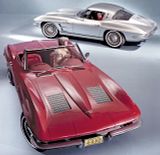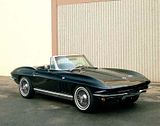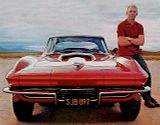The second generation or mid-year Chevrolet Corvette, designed by Larry Shinoda under the styling direction of Bill Mitchell, started in 1963 and ended in 1967. 1963 would see the introduction of the new Corvette Sting Ray coupé with its distinctive split rear window and fake hood vents as well as an independent rear suspension. The split rear window was discontinued in 1964 due to safety concerns. Because they made the design too busy, the hood vents were also cut. Power for 1963 was at 365 hp (272 kW) hitting 375 hp (280 kW) in 1964.
Four-wheel disc brakes were introduced in 1965, as was a "big-block" engine option (the 396 in³ (6.5 L) V8). Side exhaust pipes appeared on the 1965 Stingray and persisted through 1969. Chevrolet would up the ante in 1966 with the introduction of an even larger 427 in³ (7 L) version, creating what would be one of the most collectible Corvettes ever. 1967 saw a L88 version of the 427 introduced which was rated at 430 hp (321 kW), but unofficial estimates place the actual output at 550 hp (410 kW) or more. Only twenty such engines were placed in the 1967 Corvette, and the cars can fetch US$600,000 or more in auction today. From 1967-1969, the 1282 cfm Holley triple two-barrel carburetor, or Tri-Power, was available on the 427. The 1967 Corvette originally was going to be the first of the C3 generation; however, due to delays the C3 had to be put off until 1968. Other early options available on the C2 included AM-FM radio (mid 1963), air conditioning (1963), telescopic wheel (1965), head rests, presumably to prevent whiplash (1966).
The 1965 introduction of the 425HP 396 c.i. big block was ultimately the harbinger of doom for the Rochester Fuel injection system. The 396 425HP option cost $145. The 327-370HP Fuelie option cost $500. Few people could justify spending $355 more, for 55 hp less. When less than a thousand fuelie cars were built in 1965, Chevy stopped the program. It was indeed short sighted. Chevy was way ahead of it's time and had they continued every car that says Lucas or Bosch Fuel injection now, may have said Rochester. As of this writing GM does not make any carbureted cars.
In 2004, Sports Car International named the Stingray number five on the list of Top Sports Cars of the 1960s.
The design of this generation had several inspirations. The first was the contemporary Jaguar E-Type, of which Mitchell owned one and enjoyed driving it frequently. Bill Mitchell also sponsored a car known as the "Mitchell Sting Ray" in 1959, because Chevrolet no longer participated in factory racing. This vehicle had the largest impact on the styling of this generation, although it had no top and didn't give away what the coupe would look like. The third inspiration was a mako shark that Mitchell caught while deep-sea fishing.
- Luxury amenities such as power steering, air conditioning, and leather seats were first available in the 1963 Corvette.
- The earliest serial number air conditioned Sting Ray has a production build date in October, about 6 months before the rest of the A/C cars. It seems the owner was a GM executive who had the car returned to Chevrolet for refitting with A/C.
- The 1963 roof panel molds were built using wrong dimensions, such that all roof panels were too small. This left a gap seen in the door pillar above the door latch in all but a few cars. The ones where it is not found were cosmetically covered up with body filler.
- The famous "split" rear window for the new Corvette almost never came to be. It seems that Bill Mitchell and Zora Arkus-Duntov argued over the design. Bill Mitchell won out for the 1963 Model, but it was removed for 1964 never to be seen again.
- The 1963 Grand Sports, while originally looking much like the production coupes, had no body parts in common. The fiberglass body panels were roughly half the thickness of production panels to save weight.
- The 1963 Grand Sports originally were released without fender flares, using the stock look. However, they were wider to allow a wider tire 8.25x15 rather than the stock 6.70x15 tire.
- Aluminum knock off wheels only cost $322 for a set of 5 in 1964.
- Only the driver's side vent on the 1964 Corvette is functional.
- Side mounted exhaust systems first appeared in 1965.
- The first major tire size change in Corvette history occurred in 1965. Tire size changed from 6.70x15 to 7.75x15
- While the 427 was developed first, the 396 went into the Corvette, Chevrolet, and Chevelle in 1965 due to a GM policy restricting them to less than 400 cubic inches.
- The 1965 396ci 425hp engine option lasted only one year.
- 1965 was the first year to have two separate hoods - the smooth small block hood and the big block hood with a "power bulge."
- 1966 marked the last year for knock off wheels but the first for shoulder harnesses and headrests.
- The 1966 Corvette was not eligible for the SCCA Trans Am, due to the upper limit of 5.0 liter on engine displacement. Chevy's only eligible car was the Corvair.
- Only 20 RPO L88 427 engines were opted for in 1967. To discourage street use, GM rated these engines at a conservative 430 hp (5 HP less than the L71 engine option) although they actually pumped out well in excess of 500 ponies.
- 1967 was the first year to have three hood styles: the small block hood, the big block hood, and the L-88 hood, even though externally the L-88 looked like the regular big block hood.
- In late February/early March, 1967, some small blocks received the big block hood due to an manufacturing problem with the small block hood mold. These were not given the hood stripe.
- The "GM Mark of Excellence" sticker appeared, placed on the inside driver's door jamb, appeared in 1967 only.
- Federal law mandated the removal of spinners from wheels in 1967, so the knock off wheel of 1963-66 was replaced with a bolt on wheel.
- 1967 was the first year "vinyl" was offered as an optional exterior covering for the hardtop.
- The '67 model was the first to have the "tank sticker", or the build sheet, attached to the gas tank.
- A 36 gallon fuel tank, the largest ever offered, was available as an option in the Corvette from 1963 to 1967.
- The speed warning indicator option lasted for only three production years... 1967, 1968 and 1969.
- The '67 LeMans Racer was "DRIVEN" to the track from the airport (in place of being trailered) because the trailer was chuck full of parts!
| Year |
Production |
Base Price |
Notes |
| 1963 |
21,513 |
$4,037 |
New body style; only year of split-window coupe; convertible more expensive than coupe |
| 1964 |
22,229 |
$4,037 |
Single-window coupe; no more hood louvers |
| 1965 |
23,562 |
$4,106 |
396 in³ Block V8 added; last year of fuel injection until 1985; first side exhaust |
| 1966 |
27,720 |
$4,084 |
Big-Block is now 427 in³ |
| 1967 |
22,940 |
$4,240 |
Tri-power 427 would be most sought-after Corvette ever |
| Total |
117,964 |
|
|
| Engine |
Year |
Power |
| 327 in³ Small-Block V8 |
1963–1965 |
250 hp |
| 1963–1967 |
300 hp |
| 1963 |
340 hp |
| 1965–1967 |
350 hp |
| 1964 |
365 hp |
| 327 in³ Small-Block FI V8 |
1963 |
360 hp |
| 1964 |
375 hp |
| 1965 |
365 hp |
| 396 in³ Big-Block V8 |
1965 |
425 hp |
| 427 in³ Big-Block V8 |
1966–1967 |
390 hp |
| 1967 |
400 hp |
| 1966 |
425 hp |
| 427 in³ Big-Block Tri-Power V8 |
1967 |
435 hp |
|





|